Critical Analysis of Motivation and Behavior Articles - MGNT803
VerifiedAdded on 2023/06/03
|6
|1228
|415
Essay
AI Summary
This essay presents a critical analysis of two articles focusing on the role of motivation in enhancing job satisfaction and organizational behavior. The first article, by Lazaroiu (2015), emphasizes the impact of employee attitudes and the application of motivational theories, discussing Vroom’s Expectancy Theory, Locke and Latham’s Goal-setting theory, and others. The second article, by Latham and Locke (1990), explores the significance of rewards, satisfaction, and commitment, introducing ‘The High-Performance Cycle.’ The essay compares the articles, noting the different research approaches and the practical implications of each, concluding that motivation is crucial for employee performance, though the specific application requires careful consideration of situational factors. Desklib provides past papers and solved assignments for students.
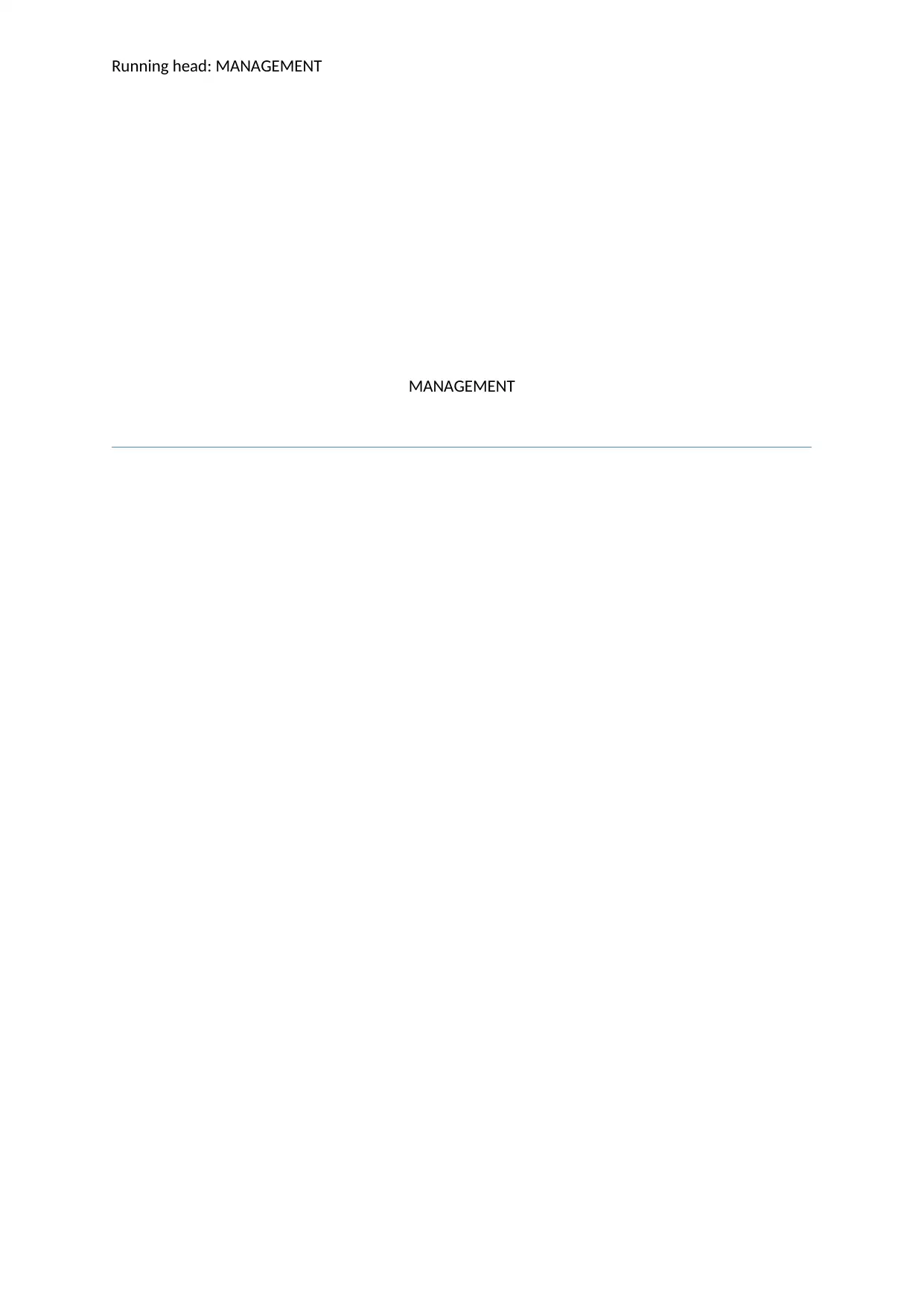
Running head: MANAGEMENT
MANAGEMENT
MANAGEMENT
Paraphrase This Document
Need a fresh take? Get an instant paraphrase of this document with our AI Paraphraser
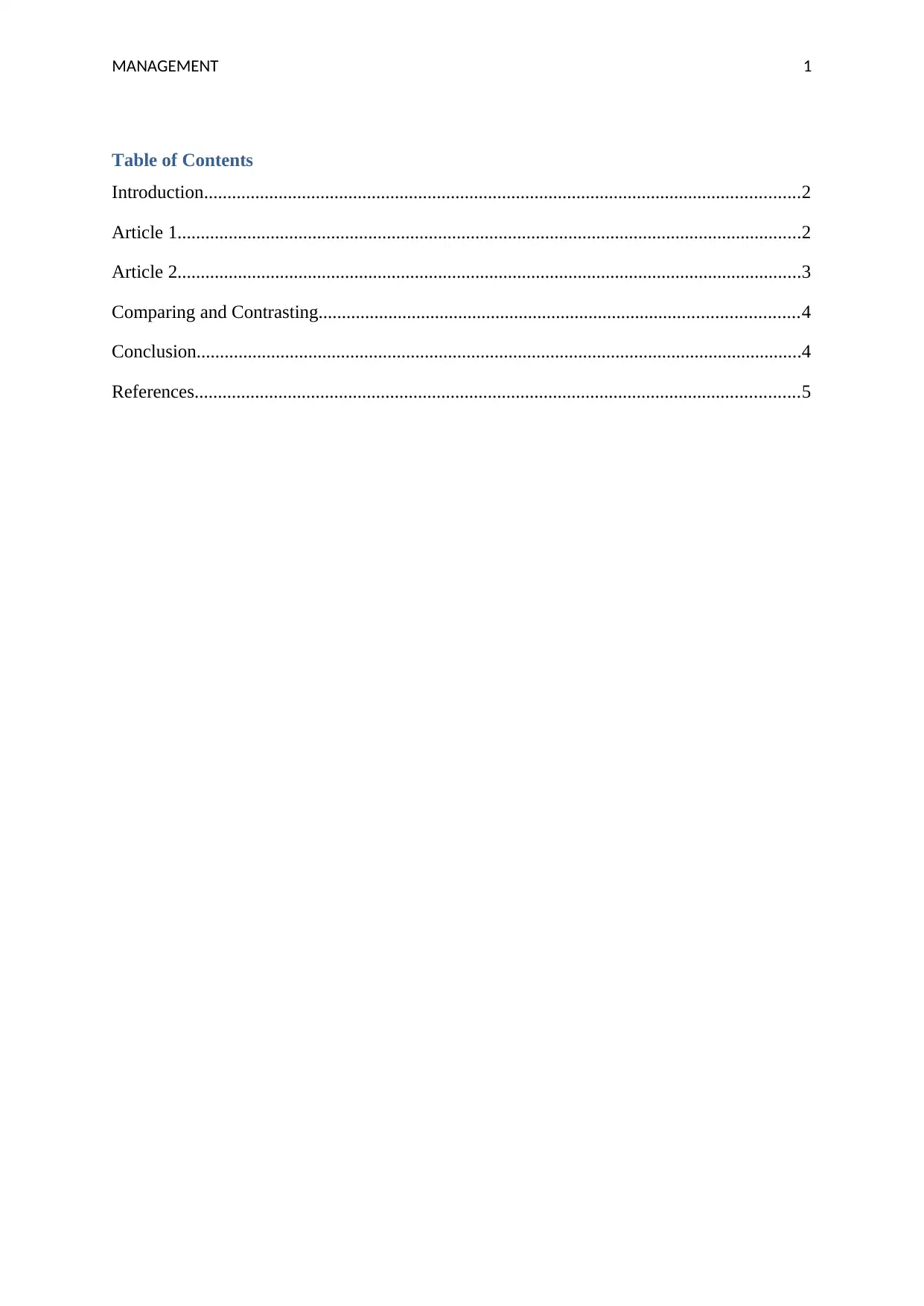
MANAGEMENT 1
Table of Contents
Introduction................................................................................................................................2
Article 1......................................................................................................................................2
Article 2......................................................................................................................................3
Comparing and Contrasting.......................................................................................................4
Conclusion..................................................................................................................................4
References..................................................................................................................................5
Table of Contents
Introduction................................................................................................................................2
Article 1......................................................................................................................................2
Article 2......................................................................................................................................3
Comparing and Contrasting.......................................................................................................4
Conclusion..................................................................................................................................4
References..................................................................................................................................5
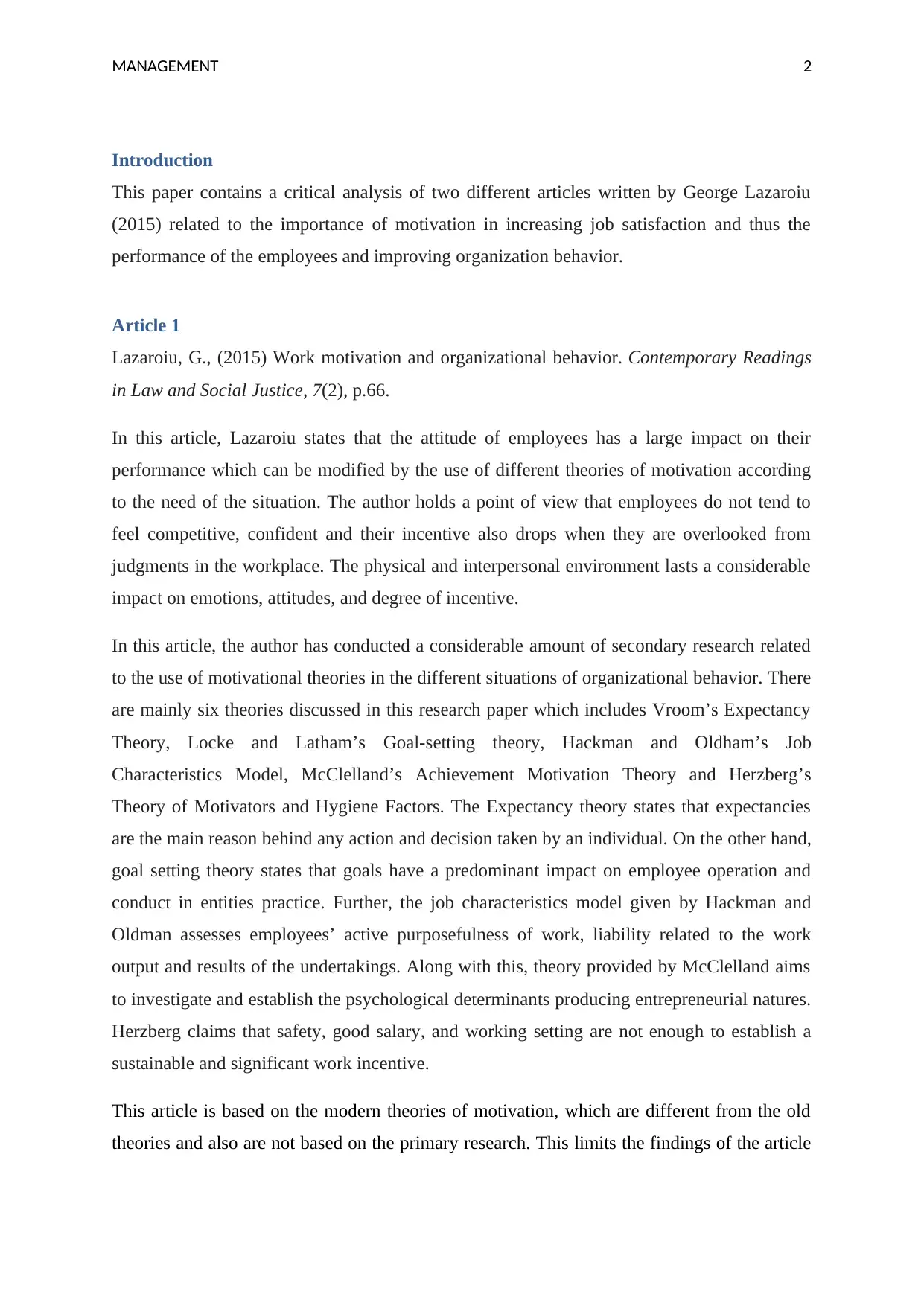
MANAGEMENT 2
Introduction
This paper contains a critical analysis of two different articles written by George Lazaroiu
(2015) related to the importance of motivation in increasing job satisfaction and thus the
performance of the employees and improving organization behavior.
Article 1
Lazaroiu, G., (2015) Work motivation and organizational behavior. Contemporary Readings
in Law and Social Justice, 7(2), p.66.
In this article, Lazaroiu states that the attitude of employees has a large impact on their
performance which can be modified by the use of different theories of motivation according
to the need of the situation. The author holds a point of view that employees do not tend to
feel competitive, confident and their incentive also drops when they are overlooked from
judgments in the workplace. The physical and interpersonal environment lasts a considerable
impact on emotions, attitudes, and degree of incentive.
In this article, the author has conducted a considerable amount of secondary research related
to the use of motivational theories in the different situations of organizational behavior. There
are mainly six theories discussed in this research paper which includes Vroom’s Expectancy
Theory, Locke and Latham’s Goal-setting theory, Hackman and Oldham’s Job
Characteristics Model, McClelland’s Achievement Motivation Theory and Herzberg’s
Theory of Motivators and Hygiene Factors. The Expectancy theory states that expectancies
are the main reason behind any action and decision taken by an individual. On the other hand,
goal setting theory states that goals have a predominant impact on employee operation and
conduct in entities practice. Further, the job characteristics model given by Hackman and
Oldman assesses employees’ active purposefulness of work, liability related to the work
output and results of the undertakings. Along with this, theory provided by McClelland aims
to investigate and establish the psychological determinants producing entrepreneurial natures.
Herzberg claims that safety, good salary, and working setting are not enough to establish a
sustainable and significant work incentive.
This article is based on the modern theories of motivation, which are different from the old
theories and also are not based on the primary research. This limits the findings of the article
Introduction
This paper contains a critical analysis of two different articles written by George Lazaroiu
(2015) related to the importance of motivation in increasing job satisfaction and thus the
performance of the employees and improving organization behavior.
Article 1
Lazaroiu, G., (2015) Work motivation and organizational behavior. Contemporary Readings
in Law and Social Justice, 7(2), p.66.
In this article, Lazaroiu states that the attitude of employees has a large impact on their
performance which can be modified by the use of different theories of motivation according
to the need of the situation. The author holds a point of view that employees do not tend to
feel competitive, confident and their incentive also drops when they are overlooked from
judgments in the workplace. The physical and interpersonal environment lasts a considerable
impact on emotions, attitudes, and degree of incentive.
In this article, the author has conducted a considerable amount of secondary research related
to the use of motivational theories in the different situations of organizational behavior. There
are mainly six theories discussed in this research paper which includes Vroom’s Expectancy
Theory, Locke and Latham’s Goal-setting theory, Hackman and Oldham’s Job
Characteristics Model, McClelland’s Achievement Motivation Theory and Herzberg’s
Theory of Motivators and Hygiene Factors. The Expectancy theory states that expectancies
are the main reason behind any action and decision taken by an individual. On the other hand,
goal setting theory states that goals have a predominant impact on employee operation and
conduct in entities practice. Further, the job characteristics model given by Hackman and
Oldman assesses employees’ active purposefulness of work, liability related to the work
output and results of the undertakings. Along with this, theory provided by McClelland aims
to investigate and establish the psychological determinants producing entrepreneurial natures.
Herzberg claims that safety, good salary, and working setting are not enough to establish a
sustainable and significant work incentive.
This article is based on the modern theories of motivation, which are different from the old
theories and also are not based on the primary research. This limits the findings of the article
⊘ This is a preview!⊘
Do you want full access?
Subscribe today to unlock all pages.

Trusted by 1+ million students worldwide
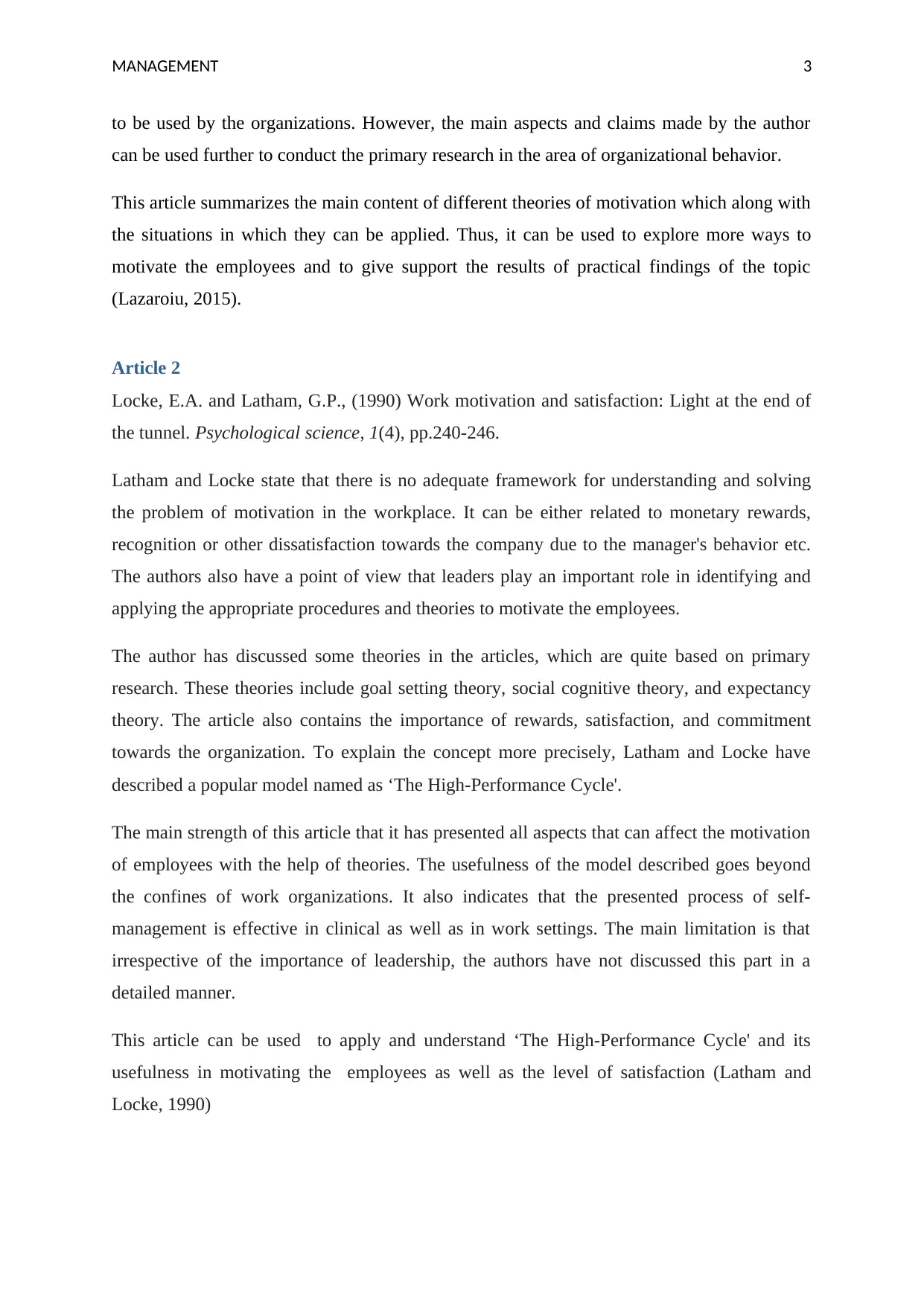
MANAGEMENT 3
to be used by the organizations. However, the main aspects and claims made by the author
can be used further to conduct the primary research in the area of organizational behavior.
This article summarizes the main content of different theories of motivation which along with
the situations in which they can be applied. Thus, it can be used to explore more ways to
motivate the employees and to give support the results of practical findings of the topic
(Lazaroiu, 2015).
Article 2
Locke, E.A. and Latham, G.P., (1990) Work motivation and satisfaction: Light at the end of
the tunnel. Psychological science, 1(4), pp.240-246.
Latham and Locke state that there is no adequate framework for understanding and solving
the problem of motivation in the workplace. It can be either related to monetary rewards,
recognition or other dissatisfaction towards the company due to the manager's behavior etc.
The authors also have a point of view that leaders play an important role in identifying and
applying the appropriate procedures and theories to motivate the employees.
The author has discussed some theories in the articles, which are quite based on primary
research. These theories include goal setting theory, social cognitive theory, and expectancy
theory. The article also contains the importance of rewards, satisfaction, and commitment
towards the organization. To explain the concept more precisely, Latham and Locke have
described a popular model named as ‘The High-Performance Cycle'.
The main strength of this article that it has presented all aspects that can affect the motivation
of employees with the help of theories. The usefulness of the model described goes beyond
the confines of work organizations. It also indicates that the presented process of self-
management is effective in clinical as well as in work settings. The main limitation is that
irrespective of the importance of leadership, the authors have not discussed this part in a
detailed manner.
This article can be used to apply and understand ‘The High-Performance Cycle' and its
usefulness in motivating the employees as well as the level of satisfaction (Latham and
Locke, 1990)
to be used by the organizations. However, the main aspects and claims made by the author
can be used further to conduct the primary research in the area of organizational behavior.
This article summarizes the main content of different theories of motivation which along with
the situations in which they can be applied. Thus, it can be used to explore more ways to
motivate the employees and to give support the results of practical findings of the topic
(Lazaroiu, 2015).
Article 2
Locke, E.A. and Latham, G.P., (1990) Work motivation and satisfaction: Light at the end of
the tunnel. Psychological science, 1(4), pp.240-246.
Latham and Locke state that there is no adequate framework for understanding and solving
the problem of motivation in the workplace. It can be either related to monetary rewards,
recognition or other dissatisfaction towards the company due to the manager's behavior etc.
The authors also have a point of view that leaders play an important role in identifying and
applying the appropriate procedures and theories to motivate the employees.
The author has discussed some theories in the articles, which are quite based on primary
research. These theories include goal setting theory, social cognitive theory, and expectancy
theory. The article also contains the importance of rewards, satisfaction, and commitment
towards the organization. To explain the concept more precisely, Latham and Locke have
described a popular model named as ‘The High-Performance Cycle'.
The main strength of this article that it has presented all aspects that can affect the motivation
of employees with the help of theories. The usefulness of the model described goes beyond
the confines of work organizations. It also indicates that the presented process of self-
management is effective in clinical as well as in work settings. The main limitation is that
irrespective of the importance of leadership, the authors have not discussed this part in a
detailed manner.
This article can be used to apply and understand ‘The High-Performance Cycle' and its
usefulness in motivating the employees as well as the level of satisfaction (Latham and
Locke, 1990)
Paraphrase This Document
Need a fresh take? Get an instant paraphrase of this document with our AI Paraphraser
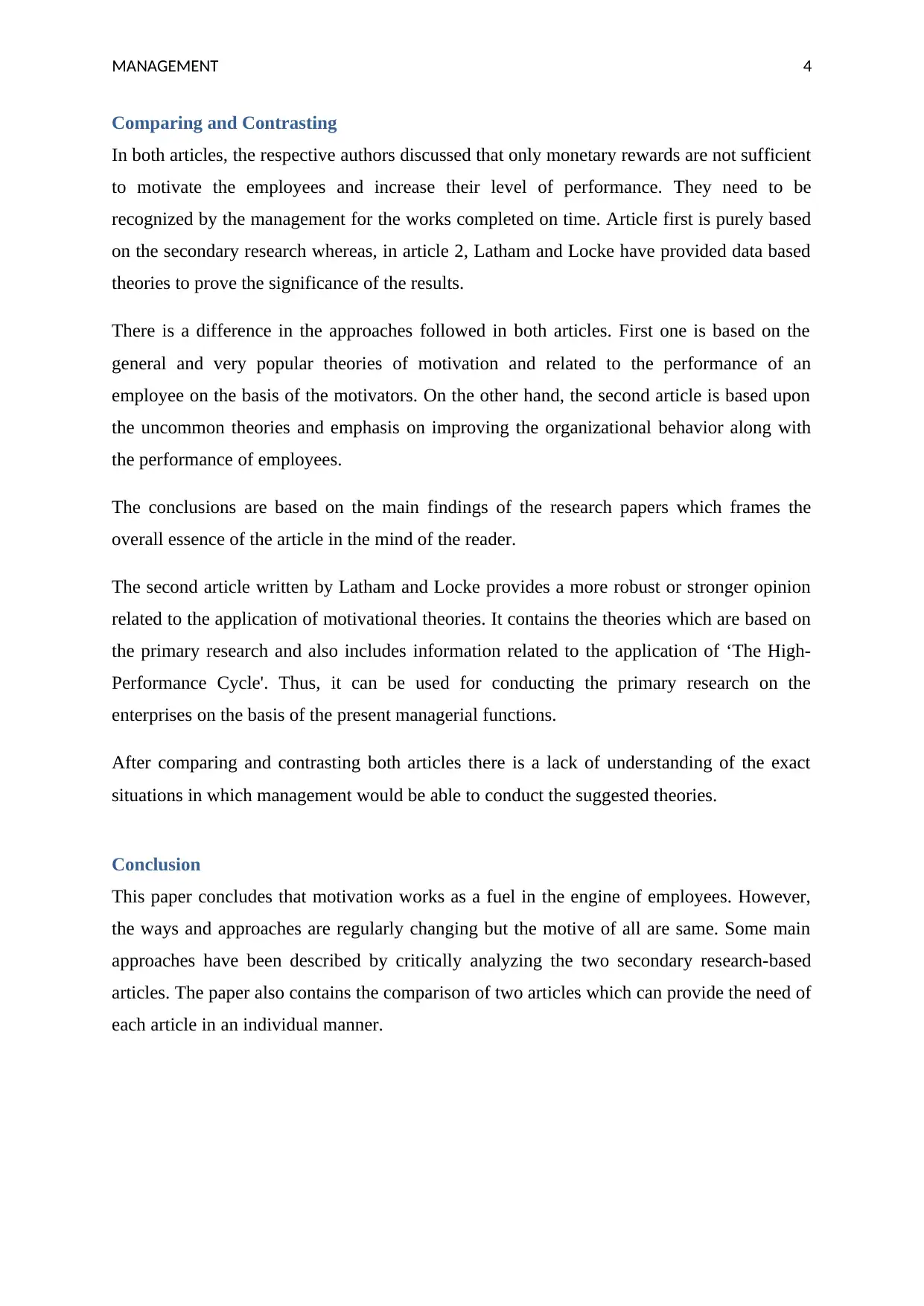
MANAGEMENT 4
Comparing and Contrasting
In both articles, the respective authors discussed that only monetary rewards are not sufficient
to motivate the employees and increase their level of performance. They need to be
recognized by the management for the works completed on time. Article first is purely based
on the secondary research whereas, in article 2, Latham and Locke have provided data based
theories to prove the significance of the results.
There is a difference in the approaches followed in both articles. First one is based on the
general and very popular theories of motivation and related to the performance of an
employee on the basis of the motivators. On the other hand, the second article is based upon
the uncommon theories and emphasis on improving the organizational behavior along with
the performance of employees.
The conclusions are based on the main findings of the research papers which frames the
overall essence of the article in the mind of the reader.
The second article written by Latham and Locke provides a more robust or stronger opinion
related to the application of motivational theories. It contains the theories which are based on
the primary research and also includes information related to the application of ‘The High-
Performance Cycle'. Thus, it can be used for conducting the primary research on the
enterprises on the basis of the present managerial functions.
After comparing and contrasting both articles there is a lack of understanding of the exact
situations in which management would be able to conduct the suggested theories.
Conclusion
This paper concludes that motivation works as a fuel in the engine of employees. However,
the ways and approaches are regularly changing but the motive of all are same. Some main
approaches have been described by critically analyzing the two secondary research-based
articles. The paper also contains the comparison of two articles which can provide the need of
each article in an individual manner.
Comparing and Contrasting
In both articles, the respective authors discussed that only monetary rewards are not sufficient
to motivate the employees and increase their level of performance. They need to be
recognized by the management for the works completed on time. Article first is purely based
on the secondary research whereas, in article 2, Latham and Locke have provided data based
theories to prove the significance of the results.
There is a difference in the approaches followed in both articles. First one is based on the
general and very popular theories of motivation and related to the performance of an
employee on the basis of the motivators. On the other hand, the second article is based upon
the uncommon theories and emphasis on improving the organizational behavior along with
the performance of employees.
The conclusions are based on the main findings of the research papers which frames the
overall essence of the article in the mind of the reader.
The second article written by Latham and Locke provides a more robust or stronger opinion
related to the application of motivational theories. It contains the theories which are based on
the primary research and also includes information related to the application of ‘The High-
Performance Cycle'. Thus, it can be used for conducting the primary research on the
enterprises on the basis of the present managerial functions.
After comparing and contrasting both articles there is a lack of understanding of the exact
situations in which management would be able to conduct the suggested theories.
Conclusion
This paper concludes that motivation works as a fuel in the engine of employees. However,
the ways and approaches are regularly changing but the motive of all are same. Some main
approaches have been described by critically analyzing the two secondary research-based
articles. The paper also contains the comparison of two articles which can provide the need of
each article in an individual manner.
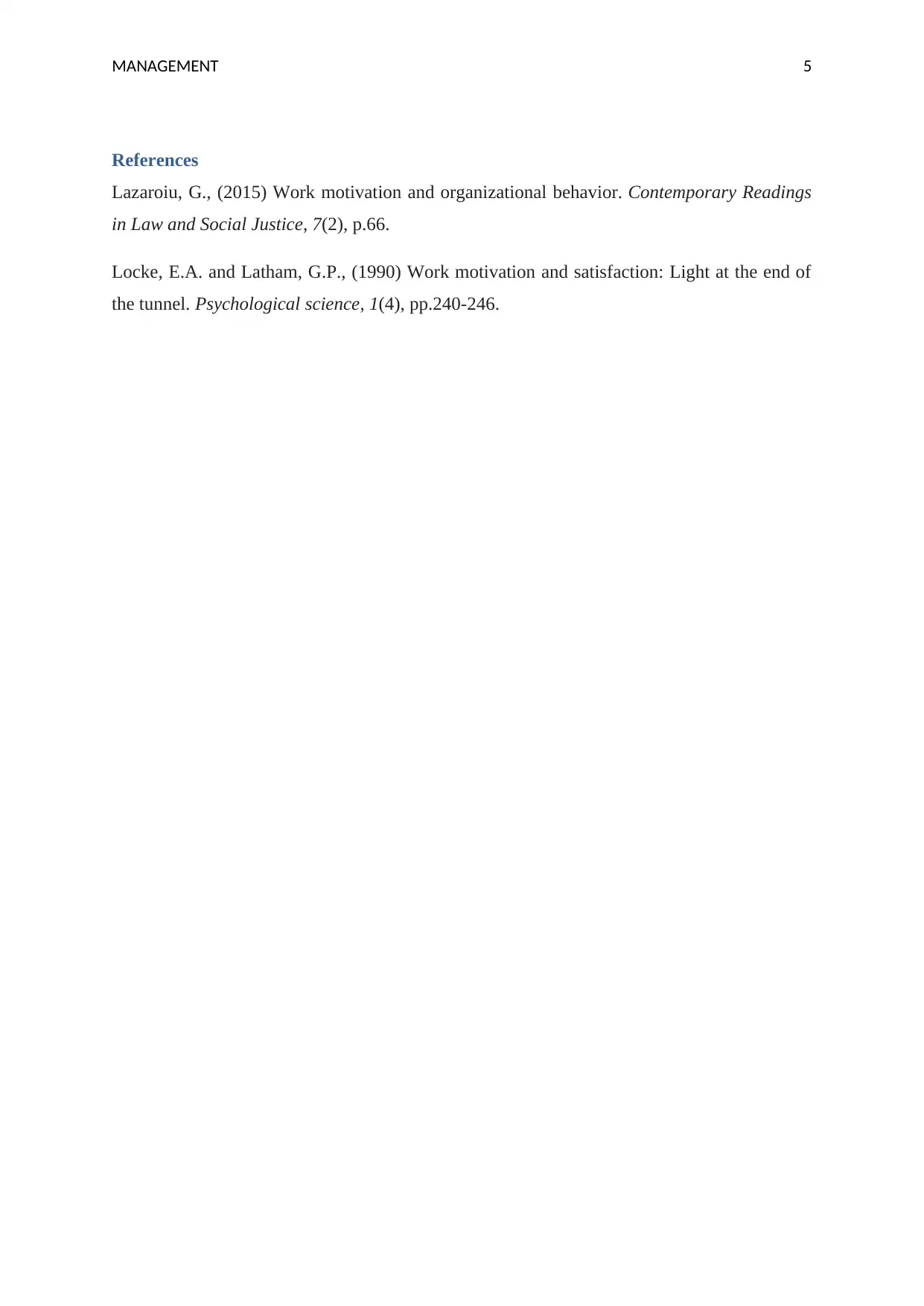
MANAGEMENT 5
References
Lazaroiu, G., (2015) Work motivation and organizational behavior. Contemporary Readings
in Law and Social Justice, 7(2), p.66.
Locke, E.A. and Latham, G.P., (1990) Work motivation and satisfaction: Light at the end of
the tunnel. Psychological science, 1(4), pp.240-246.
References
Lazaroiu, G., (2015) Work motivation and organizational behavior. Contemporary Readings
in Law and Social Justice, 7(2), p.66.
Locke, E.A. and Latham, G.P., (1990) Work motivation and satisfaction: Light at the end of
the tunnel. Psychological science, 1(4), pp.240-246.
⊘ This is a preview!⊘
Do you want full access?
Subscribe today to unlock all pages.

Trusted by 1+ million students worldwide
1 out of 6
Related Documents
Your All-in-One AI-Powered Toolkit for Academic Success.
+13062052269
info@desklib.com
Available 24*7 on WhatsApp / Email
![[object Object]](/_next/static/media/star-bottom.7253800d.svg)
Unlock your academic potential
Copyright © 2020–2025 A2Z Services. All Rights Reserved. Developed and managed by ZUCOL.





